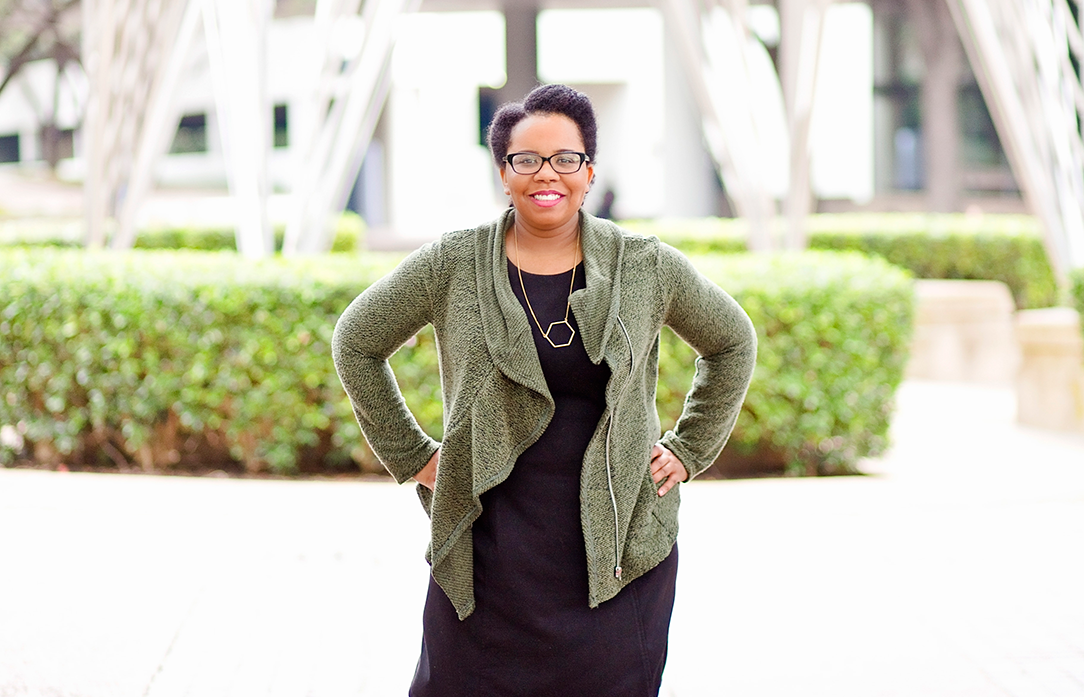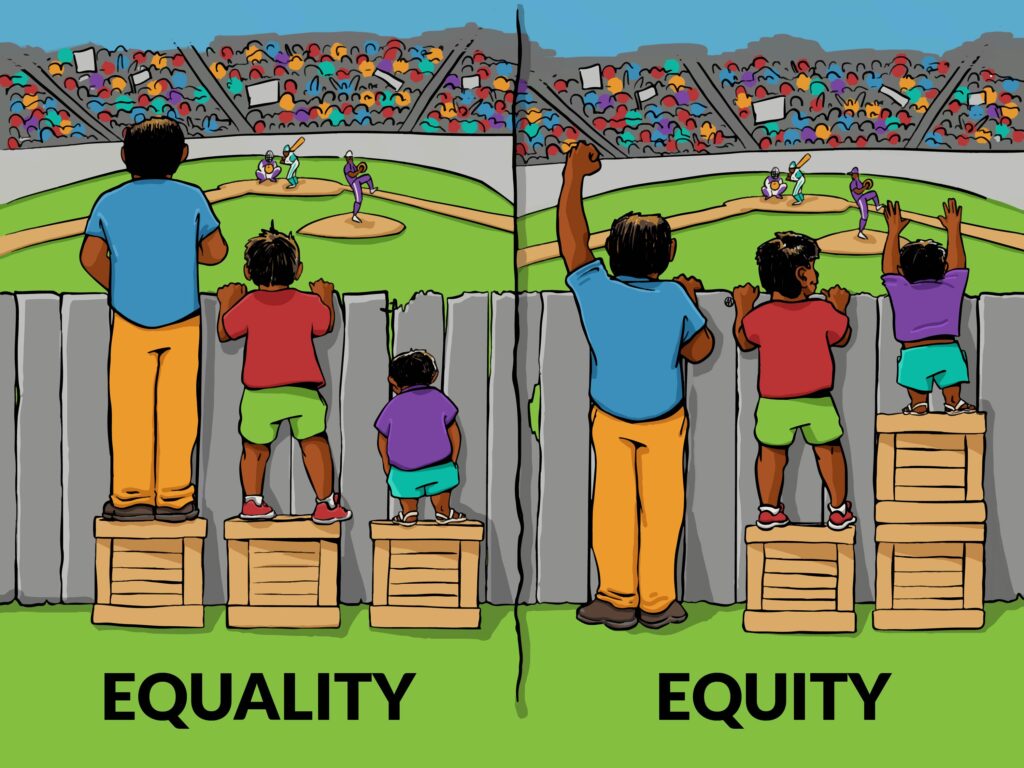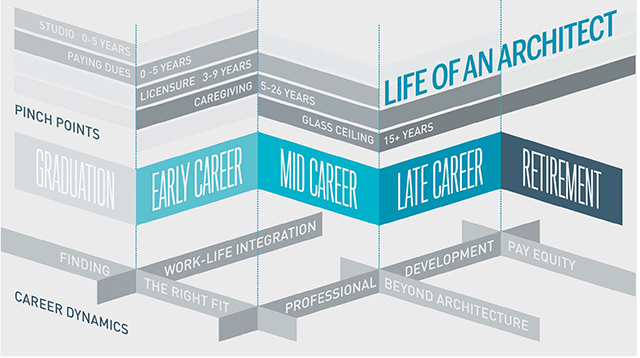Towards Equity
 Gianna Pigford // Photo by Alicia Spaete
Gianna Pigford // Photo by Alicia Spaete
“At this point in my career, I simply will not be denied a seat at the table, even if I have to build the seat myself.”
WHO AM I?
I’m 41 years old. Seventeen plus years of my life have been spent trying to fit into the architecture community. I’m a black female architect.
I’ve been called a diva, told I wasn’t assertive enough, told to watch my tone, told that I wasn’t confident, told I act like I know everything, spoken of as though I know nothing … Well admittedly, I am stubborn and tenacious while sometimes quiet and reserved. (By the way, this is not a recommended character trait combination.) A few years ago, I was struggling to overcome some career hurdles and a friend gave great advice: “Be who you were meant to become.” At this point in my career, I simply will not be denied a seat at the table, even if I have to build the seat myself.
In reality, anyone should have an opportunity to occupy any given seat without barriers, gaps, and roadblocks preventing access. Perhaps the emerging gray hairs have brought some wisdom in that I no longer complain and sulk about what I have not been given. So no, I didn’t encounter my first mentor until age 37. I didn’t have the sensei to groom my leadership abilities and professional acumen. I accept that my process shouldn’t have been as fraught with missteps, but it was. I am the product of many false starts and giant leaps of faith.
WHAT’S MY STORY?
In short, I grew up in Deep South Mississippi where I dealt with almost every socio-economic statistic that is known. When I decided I wanted to become an architect, I couldn’t even correctly pronounce the word. Without pure luck and happenstance, I would not have entered into the school of architecture because I certainly did not know any architects nor have means to connect with them as my post high school guidance narrowed quickly to just me. I didn’t know there was a separate school of architecture application beyond the general university admission requirements. By luck, I ran into the dean of the Mississippi State University School of Architecture and my father happened to mention my name to an architect.
I hastened my A.R.E. testing to become one of the first black female architects licensed in Mississippi after I had learned there were none licensed in the state. But once licensed, I didn’t push to be given opportunities on projects that would stretch my capabilities or develop the required professional soft skills. Unfortunately, I thought hard work alone was the key to a successful career. Once enlightened, I joined the various organizations and leadership development programs that would give me the industry exposure and leadership skills that I lacked. I’ve since become an active leader in my architecture firm and community.
Not everyone is as lucky, or stubborn enough, to overcome the challenges. So how is access to the profession granted and how is it sustained when one doesn’t have circumstance and means of their own? Exclusion exists. Once we all nod our heads together and agree on that, we can move on to address equity. I know for a lot of those in my African-American community if a change is coming it will have to start with my round brown face. I have to be a part of the pipeline that smooths the process for those minorities entering the profession.
WHAT IS EQUITY?
Some confuse the word equality with equity, but they are not the same and should not be used interchangeably. Per Merriam Webster, equality is defined as “the quality or state of being equal” whereas equity in this context is defined as “fairness or justice in the way people are treated.” Equity is not about leveling the playing field—that is equality, and equality is nearly impossible to achieve within the construct of current society. An equitable environment intends that everyone is given the resources they need to thrive, as opposed to an equal environment in which everyone is given exactly the same resources. An excellent example of equality versus equity that many may have seen is the cartoon where three youths of different heights are standing at a fence. If given equally sized boxes to stand on, the shortest person still cannot see over the fence. However, this is easily mediated if the tallest person, who doesn’t need the box to see over the fence, gives his to the shortest person.
Thus, without equity, the career achievements of minority architects will be different than those of affluent white men in architecture. To address equity in architecture, we need to go beyond inclusion alone, that notion that a minority represented on a project team or firm’s organizational chart is enough. Equity is more than that. A more equitable architectural profession is one in which the disparity in access to higher education, job opportunities, career development, and firm leadership is eliminated. Those underrepresented demographics in terms of race, ethnicity, gender, country of origin, religion, sexual orientation, physical ability, age, and so forth have much to bring to the profession and should be supported with their diversity leveraged for the benefit of society and the built environment.

WHY DOES IT MATTER?
I’m deeply honored to be asked to write this piece, not because “equity” is a current buzzword in the architecture community, but because it is important that I exist as a representative in this community. I speak to college, high school, and elementary students at almost every opportunity I get because my existence matters. I will likely be the only black female architect that they will ever meet in their lifetime. I know this because I met my first African-American female architect, Charyl McAfee-Duncan, FAIA, at age 32. In a recent conversation with a recent college graduate, a woman of color, I asked, “How many black female architects do you know?” Her answer: “Until now, I hadn’t met any.
I always count. I mean literally, I count the number of minorities in architecture. It is as natural as daylight for me to notice how many minority architects are in the room—be they female or ethnic minority. When I’m involved in an industry-related organization, I take a look at how many are on the board or within architecture firms, how many minorities lead task forces, committees, events, and so on. I’ll attend an AIA event this week, and yes, I’ll count. In an office of over 200 professionals, I am one. When over 230 titled staff members gather as a representation of regional firm leadership, I am one. Yes, the only black female architect in the room.
To speak of women in architecture, at some point you look around and wonder, where are they? Even though my college graduating class was almost equally male and female, there is a significant number of the women architects that are no longer practicing. The recent “Equity in Architecture Survey 2016 Early Findings Report” show that the five career “pinch points” for women still exist. This report completed by the AIASF Equity by Design (formerly The Missing 32% Project) looks at how women are underrepresented in the profession and what obstacles they face. It is intended that the survey will enlighten the industry on how gender and race differences limit career potential and challenge employee retention. How will academia and the profession mitigate the disparity?

Gender barriers are discriminatory and disruptive to career ascension. The World Economic Forum’s Global Gender Gap Report notes the gaps between men and women on economic, political, education, and health criteria by country. It aims to create awareness and challenges a global audience to reduce those gaps. The United States ranks 45th in the organization’s 2016 Gender Gap Index. According to this study, there is a noticeable gap between men’s and women’s access to resources and opportunities, which inhibits women’s economic gains and societal achievements. Yes, most women and men know this, yet the gap exists with no actionable item being presented as to how it can be eradicated.
Australia has made considerable strides to close its gender gap. Parlour, an organization focused on promoting gender equity in Australian architecture, has conducted extensive research to show that the pay gap (I really tried not to mention this) and other unequitable practices exist. It also identifies ways to do away with these. Consequently, (in association with the Australian Institute of Architects) the “Parlour Guidelines to Equitable Practice” were released in 2014 with the primary resolve to stop women from leaving architectural practice. This guideline is intended to help Australian architecture firms open dialogue and develop strategies for work-life balance, transparent pay (dang, mentioned it again), equal training opportunities, supportive workplace environments, recruitment, leadership, breaks away from career, and advancement. Parlour’s platform is robust and enviable and I hope to see a comparable network of like minds here in the United States. Assuredly, all of the very same architecture ills that Australia faces reside on our soil, too.
Equity is everyone’s issue. It does not only belong to the disenfranchised women and other minorities in architecture. We, the architecture community as a whole, should believe that diversity in representation matters. Those designing for a diverse environment should be reflective of that environment.
AN EQUITABLE FUTURE
On March 12, 2007, I received my congratulatory letter from the Mississippi State Board of Architecture that notified me that my application for registration was approved. That same month, ARCHITECT magazine had a black woman on the cover with the feature story titled “0.2%.” I remember calling the one other black woman who graduated with me from Mississippi State University—we cried together. These two items, magazine and letter, now quietly sit on a shelf in my house, speaking loudly of what few forward movements have been made.
That particular magazine article referenced the Directory of African American Architects and the 196 black women licensed to practice architecture out of approximately 91,000 registered in the United States. I was either number 201 or 202 to be listed. Per the current Directory of African American Architects database, there are now 2,082 licensed African-American architects listed, and of those there are 378 licensed women. In a state of more than 11,500 licensed architects, I am one of 21 black women. In the Dallas/Fort Worth area, I am one of five licensed black female architects.
The Institute has long identified diversity and inclusion as a strategic goal for the profession. However, the rate of impact has not been significant enough to advance the ratio of underrepresented populations within the profession, with the greatest disparity being evident in leadership and ownership positions. The Institute encourages our global society to “Look Up”, elevating the value of architecture and the services that architects provide. Concurrently, there needs the be a reflective look at valuing our human capital within the profession. Equity is everyone’s issue and achieving equitable practice has a direct impact on the relevance, economic health, and future of the Institute and our profession.
AIA Resolution 15-1
In a short few months, it will be 10 years since I became a registered professional. I would like to say that huge strides have been made, and in some regard they have, but in reality there have been minute steps forward with a nod to the future. In the past two years, we have seen the momentum building with the first Equity by Design survey and report issued in 2014, Rosa Sheng’s 2015 TEDx Philadelphia speech “Why Does Equity in Architecture Matter,” and the release of last year’s 2016 Women in Architecture Survey.
What does the architecture community look like today and what is our future? So here is the dimly lit hope that sits on the horizon. In 2015, AIA San Francisco and the AIA Council sponsored a resolution that was passed overwhelmingly by the AIA membership. More than a year has passed since “Resolution 15-1: Equity in Architecture” was approved and the Equity in Architecture Commission was established, but I’m hopeful that those I personally know who were appointed to this commission will indeed “utilize metrics-driven knowledge, collaborative discussion, and definitive action to develop specific recommendations that will lead to equitable practices, investing in a diversity that mirrors society at large within all levels of the Institute, academia, and the profession of architecture.”
So until that equitable future sits more brightly on the horizon, I’ll speak, I’ll participate, I’ll mentor, I’ll teach, and yes, I’ll continue to count. Perhaps one day in the not-so-distant future, “diversity and inclusion” will no longer be a distinction necessitated by its absence, and I’ll simply be Gianna Pigford, architect.
This article originally appeared in the Winter 2017 “Equity” issue of AIA Dallas Columns magazine.